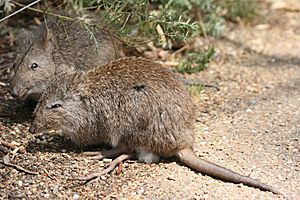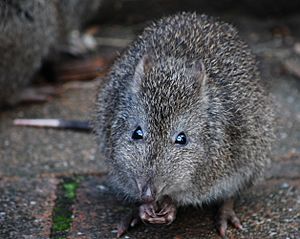Long-nosed potoroo facts for kids
Quick facts for kids Long-nosed potoroo |
|
|---|---|
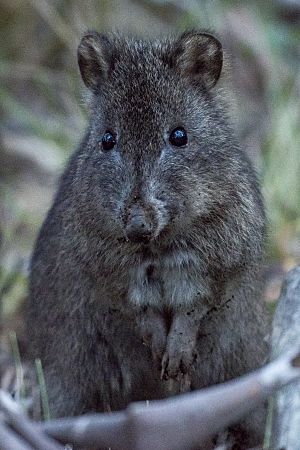 |
|
| A long-nosed potoroo in Tidbinbilla Nature Reserve, Australia | |
| Conservation status | |
| Scientific classification | |
| Genus: |
Potorous
|
| Species: |
tridactylus
|
| Subspecies | |
|
|
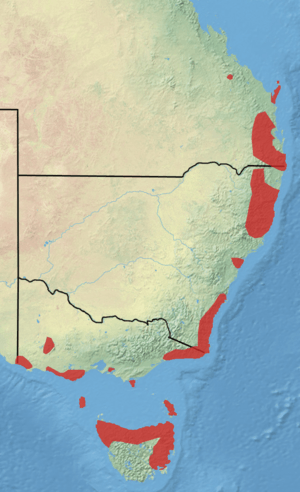 |
|
| Where the long-nosed potoroo lives | |
The long-nosed potoroo (Potorous tridactylus) is a small marsupial from Australia. It belongs to the rat-kangaroo group, which are like mini-kangaroos.
This animal has a long, pointed nose and grey-brown fur. At first glance, it might look like a bandicoot. But when it hops, tucking its front feet into its chest, you can see its close link to the kangaroo family.
Long-nosed potoroos have special body features. These include their long nose, upright ears, big eyes, and strong claws for digging. They also have powerful back legs for hopping. They are quite small, with a body length of about 34 to 38 cm (13 to 15 in). Their tail is about 15 to 24 cm (5.9 to 9.4 in) long and can grip things.
It's rare to spot a long-nosed potoroo in the wild. But you can often find signs they've been around. Look for paths they make through thick plants or hollows they dig when searching for food.
Contents
About the Long-Nosed Potoroo
The long-nosed potoroo was first written about in 1790. This was by John White during his trip to Botany Bay in Australia. He called it a "Poto Roo" or "Kangaroo Rat" and included a drawing.
The scientific name for the group of potoroos, Potorous, has changed many times. Here are some other species in the same group:
- P. gilbertii (Gilbert's potoroo)
- P. longipes (Long-footed potoroo)
- P. platyops (Broad-faced potoroo), which is now extinct
- P. tridactylus (Long-nosed potoroo)
- Potorous tridactylus tridactylus (found on mainland Australia)
- Potorous tridactylus apicalis (found in Tasmania, often with lighter fur)
Where They Live
Long-nosed potoroos live in different places across Australia. You can find them in the Southern Highlands of New South Wales and in south-western Victoria. They also live on the island of Tasmania.
In the past, they lived in more areas than they do today. Their bones have been found in many cave deposits. These animals like different kinds of plants, from warm rainforests to thick coastal heath areas.
What they need most is thick plant cover on the ground. This helps them hide and find materials for their nests. They also prefer soft soils that are easy to dig. This is because they dig for underground roots and fungi to eat.
The area a potoroo uses, called its home range, can be different sizes. In Tasmania, their home ranges can be large, from 5 to 20 hectares (12 to 49 acres). Males often use more land than females. But in Victoria, their home ranges are much smaller.
Daily Life and Behavior
Long-nosed potoroos usually live alone. They only meet up briefly to mate or when a mother is with her young. Sometimes, a few males and females might feed together in a loose group.
They don't defend their territory strictly, and their home ranges often overlap. A male's home range might overlap with several females' areas. But a female's home range is usually just for her. This means females can find males all year round. However, most breeding happens from late winter to early summer. Females can have up to two litters of babies each year.
These potoroos are nocturnal, meaning they are active at night. They spend most of their time hidden in thick plants. They use their long, slightly curved claws on their front feet to dig for food.
They are omnivores, eating both plants and animals. Their diet includes underground fungi, roots, fruits, flowers, seeds, and insects. Fungi are a very important part of their diet, with over 50 types eaten depending on the season. In fall and winter, they mostly eat fungi and seeds. In spring and summer, they eat more arthropods (like insects), plant parts, fruits, and flowers.
When looking for food, the long-nosed potoroo sniffs the ground, moving its nose from side to side. Once it smells something, it starts digging with its front paws.
Because they eat fungi, they help spread fungal spores through their droppings. Some of these fungi grow on the roots of native plants. They help the plants get nutrients from the soil, which is very important for the environment.
Threats to Potoroos
The long-nosed potoroo was one of the first marsupials that European settlers saw. Sadly, these early meetings happened as human settlements grew. This led to much of the potoroo's habitat being cleared for farms and other uses.
Today, long-nosed potoroos face many dangers. These include wild cats, wild dogs, and red foxes. Human settlements also cause problems, leading to their habitat being broken up or lost. Farming, livestock grazing, and bad fire management also harm them.
The way fires are managed in their remaining habitats has changed. More severe and frequent fires create open areas with little plant cover. This leaves small mammals like the potoroo with nowhere to hide.
The long-nosed potoroo is listed as Near Threatened by the IUCN Red List. This means it could become endangered soon. It is also listed as Vulnerable in Queensland and nationally in Australia. In Victoria, it is considered endangered.
Helping Potoroos Recover
Many efforts are being made to help the long-nosed potoroo. These include:
- Controlling the number of foxes.
- Managing weeds that harm their habitat.
- Making sure fires are managed in a way that helps the environment.
- Connecting different areas of their habitat with special paths or barriers.
- Stopping the spread of diseases, like Phytophthora sp..
- Keeping livestock away from their habitats.
- Protecting the areas where they are known to live.
- Teaching the public about these animals.
Scientists are also doing more research to help. They are:
- Estimating how many potoroos there are.
- Studying genetic differences between groups.
- Learning more about what they eat.
- Finding out how human activities, like using fertilizers, affect the fungi they eat.
- Understanding how predators affect their numbers.
- Deciding if captive breeding programs are needed to release them back into the wild.
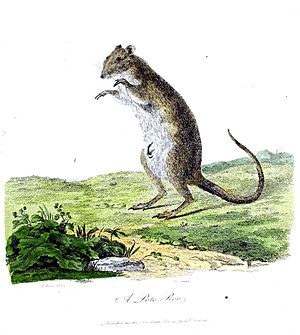
Monitoring of the long-nosed potoroo is ongoing while a full recovery plan is being prepared.
See also
 In Spanish: Canguro rata de hocico largo para niños
In Spanish: Canguro rata de hocico largo para niños



